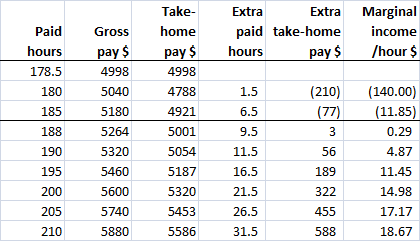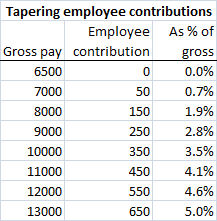Minimum wage will reduce some incomes
2 January 2011
In a classic demonstration of how the road to Government intervention is paved with unintended consequences, when the Minimum Wage Ordinance (MWO) comes into effect on 1-May-2011, paradoxically, some employees are actually going to suffer a drop in their take-home pay. Yes, you read that right, and no, we are not talking about those who lose their jobs. Why the paradox? Blame another piece of interventionist legislation, the Mandatory Provident Fund Schemes Ordinance (MPFSO).
The MPFSO requires that anyone earning the "minimum level of relevant income" is required to contribute 5% of it (up to the "maximum level of relevant income") to the compulsory savings scheme, which the employer must deduct from the wages. Currently, the minimum is HK$5k per month; it was raised in February 2003 from $4k/m. The maximum is $20k/m.
After much wrangling over what will be a biennial political hot potato, the minimum wage has been set at $28 per hour. So the $5k minimum relevant income level for MPF corresponds to about 178.6 paid hours at the minimum wage. The Government estimates that 314,600 employees will be affected by the minimum wage. Within them, most were earning less than $5k per month, and some of those will now cross that boundary, at which point their take-home pay will drop by $250, being 5% of their salary siphoned off into the MPF. Anyone previously earning between $4,750 and $4,999 could find themselves with lower take-home pay as a result.
For example, if an employee was earning $27.75 per hour and was paid for 180 hours per month (including credit for statutory holidays and annual leave), then she was taking home $4,995. Her gross pay will now increase to $28 per hour, making $5,040, of which $252 will go into the MPF, and she will take home $4,788. She will have a drop of $207 or 4.1% in take-home pay. The Government may argue that the MPF is not money wasted, but try telling that to someone who is trying to put rice in the bowl today, not in 40 years' time.
Marginal income and the work incentive
Beyond $5k of gross pay, every hour at the minimum wage gives the employee take-home pay of $26.60 (95% of $28), so it will take an extra 9.4 paid hours to recover the initial $250 removed by the MPF when crossing the $5,000 mark. So working to the nearest half-hour, it is only worth getting paid for either 178.5 hours per month (for $4,998), or at least 188 hours per month (for take-home pay of $5,000.80). That's an extra 9.5 paid hours for $2.80 of take-home pay. The effective marginal take-home pay for each of those extra hours is $0.29 per hour.
In more detail, here's what the work incentive looks like, relative to 178.5 paid hours at the minimum wage:

Note that in the above calculations, we have used the term "paid hours". That is because the highly interventionist Employment Ordinance imposes a requirement to pay for 12 statutory holidays each year, and also for a minimum number of annual leave days following a complicated formula depending on the period of employment, starting with 7 days per year and building to 14 days after 9 years of service. The rate of pay for these prescribed days is the same per day as the average daily wage on real working days. So "paid hours" includes the same number of hours on each of those days as is worked on other days. For example, someone on a 6-day week with 7 years of service would get 24 days per year off, or 2 days per month, and still be paid for those days.
There are 365.2425 days in an average Gregorian year, so for those working a 6-day week, there are about 313.1 working days in a year, or about 26.1 days per month, minus statutory holidays and leave days. So it only takes about 6.84 paid hours per day for someone on a 6-day week to be pushed over the $5k threshold and into the MPF trap. If the threshold is raised to $6k, then it will take about 214.3 hours, or 8.2 hours per day, or 49 hours for a 6-day week, before someone faces an MPF deduction. According to the Census and Statistics Department, in the 3 months to Oct-2010, the median worked hours per week (excluding meal breaks) was about 48, so half the population works longer than that. In "retailing, accommodation and food services" the median was 54 hours. In another table, we see that 790,000 people, or 22% of the workforce, worked at least 55 hours per week. That would probably include a lot of security guards on 12-hour shifts.
Also, keep in mind that some months have more work days than others. In a 31-day month, it is possible to have only 4 rest days and 27 work days. If that happens, then someone on hourly pay for an 8-hour day would notch up 216 hours, tipping them over the $6k threshold at $6048. So to avoid this risk and cater for some of those who work longer hours, the threshold should be raised to at least $6,500.
In summary, unless the MPF minimum relevant income is raised substantially, most full-time workers on minimum wage will be forced to contribute to the MPF. To prevent most minimum-wage workers be hit with an MPF deduction, Webb-site calls on the Government to raise the minimum level of relevant income to at least $6,500.
The marginal income per hour tabulated above demonstrates why an increasing number of workers will seek part-time jobs (or self-employment) rather than work themselves into the MPF and earn very low rates of marginal take-home pay. There is very little work incentive beyond 178.5 paid hours per month. Each employment contract is assessed separately for MPF limits, so if a person has two jobs, each of which pays less than $5,000, then he will not have to contribute to the MPF. Of course, finding additional jobs is easier said than done, and most workers will just have to take the hit on their take-home pay.
To protect the work incentive, employee contributions should only be levied on the excess over the minimum, not on the whole amount. With a minimum of $6,500, contributions could be tapered by charging 10% on the amount between $6.5k and $13k, so that the percentage of gross pay escalates from 0% to 5% of relevant income. This is shown in the table below.

MPF costs
It is true that the employee (if she lives to 65) will eventually enjoy the benefit of whatever remains of her MPF contributions after the trustees and fund managers have gorged themselves on fees, but that is not much comfort to a young employee for whom $250 or $325 per month (5% of the minimum relevant income for MPF) could make a difference to their quality of life today, not in 40 years' time. As a reminder, here is a table from our article of 23-Jun-2005, showing how much of your capital and returns will be lost in expenses over different periods of investment:

Total expense ratios continue to average around 2%, so the table shows that 55.4% of the capital and returns for an investment made now will be taken as fees and other expenses over the next 40 years. For an 18-year-old just starting the MPF, he actually has 47 years before it pays out, so make that 61.3% on his first payment. For this reason alone, there is a strong argument that younger employees should be exempted from the MPF while they try to make a start on their adult lives, perhaps only requiring contributions over the age of 40. At least they will then only have to tolerate 25 years of fees, or 12.5 years on the average payment.
Min-max review
After legislative amendments passed on 12-Jul-2002, Section 10A of the MPFSO requires that at least once in every 4 years thereafter, the MPFA will review the minimum and maximum relevant levels of income and make recommendations to Government. That means that another review was due in 2010. The levels must "take into account" 50% of the monthly median employment earnings when determining the minimum, and the 90th percentile of monthly employment earnings when determining the maximum (i.e. the level above which 1 in 10 of the working population receives). Both are estimated using the Census and Statistics Department's General Household Survey (GHS), which of course is subject to sampling errors, under-declaration (particularly by people who are claiming means-tested benefits and public housing) and seasonality of earnings. Here's the latest issue.
Upon the 2006 review, there was a proposal on 28-Dec-2006 from the MPF Authority to raise the maximum relevant income from $20k to $30k. This was strongly opposed by Webb-site and others. See our article "Stop the Increase", 11-Feb-2007, for detailed arguments. We and others made submissions to the Legislative Council on the matter. In response to that opposition, the proposal was quietly dropped by the Government. The minimum relevant income was not proposed to be changed.
The minimum wage will shift the wages of the lowest income workers upwards, equalising them all at $28 per hour (except for those who lose their jobs), but it will not change the median, which is, by definition, the income earned or exceeded by 50% of the workforce. This median has increased from $10,000 in the quarter to 30-Sep-2006 to $11,000 in the quarter to 30-Sep-2010. This would indicate a raise in the minimum relevant income level, but only from $5,000 to $5,500. This would spare some of the lowest-paid workers from losing another $275 per month to the MPF, but of course, there would be many others who would still fall into the MPF trap. The MPFA has not yet announced its recommendations for 2010.
According to the same GHS survey, 9% of the workforce earned more than $35k and 4.1% earned between $30-35k, so the 90th percentile is around the $33k mark. Furthermore, 24.2% of the workforce earned more than $20k in the quarter to 30-Sep-2010.
Let us hope that, again, the maximum relevant income is not raised. Hong Kong should not become a nanny state. If the top-earning quartile of the workforce cannot be trusted to manage their own savings on a voluntary basis, then the Government is insulting the intelligence of the professional classes.
As we've consistently said, the MPF is a highly interventionist interference in personal choice and should be abolished, but until it is, at least spare the lowest income workers from the pain of unintended consequences.
© Webb-site.com, 2011
Organisations in this story
Topics in this story
Sign up for our free newsletter
Recommend Webb-site to a friend
Copyright & disclaimer, Privacy policy


